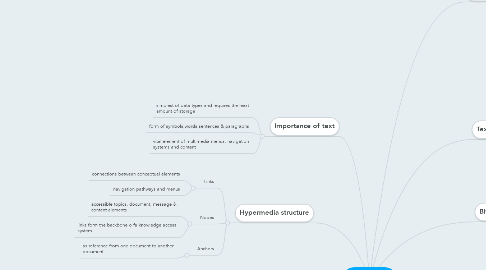
1. Importance of text
1.1. simplest of data types and requires the least amount of storage
1.2. form of symbols,words,sentences & paragraphs
1.3. vital element of multimedia menus, navigation systems and content
2. Font editing and design tools
2.1. Fontographer
2.1.1. a specialized graphics editor
2.1.2. can modify existing typefaces & incorporate PostScript artwork
3. Hypertext
3.1. text which contains links to other texts
3.2. subset of hypermedia
4. Hypermedia
4.1. not constrained to be text-based
4.2. it can include other media
5. Hypermedia structure
5.1. Links
5.1.1. connections between conceptual elements
5.1.2. navigation pathways and menus
5.2. Nodes
5.2.1. accessible topics, document, message & content elements
5.2.2. links form the backbone o fa knowledge access system
5.3. Anchors
5.3.1. as reference from one document to another document
6. Understanding fonts & typefaces
6.1. Typeface
6.1.1. family of graphic characters
6.1.2. often with many type sizes & styles
6.2. Font
6.2.1. collection of characters of single size
6.2.2. style belonging to a particular typeface family
6.3. Fonts & typeface includes
6.3.1. Font styles
6.3.1.1. Boldface
6.3.1.2. Italic
6.3.1.3. Underlining
6.3.1.4. Outlining
6.3.2. Font terminology
6.3.2.1. Baseline
6.3.2.2. Cap height
6.3.2.3. x-height
6.3.2.4. Ascenders/descenders
6.3.2.5. Kerning
6.3.2.6. Tracking
6.3.3. Cases
7. Text element
7.1. Menus for navigation
7.2. Interactive buttons
7.3. Fields for reading
7.4. HTML documents
7.5. Symbols and icons
8. Bitmap
8.1. Bitmap font
8.1.1. consist of matrix of dots/ pixels representing the image
8.1.2. File size increase as more sizes are added
8.1.3. require a lot of memory
8.1.4. non-scalable
9. Vector
9.1. Vector fonts
9.1.1. drawing use instructions & mathematical formulae
9.1.2. can draw any size by scaling the vector
9.1.3. file size much smaller than bitmaps

